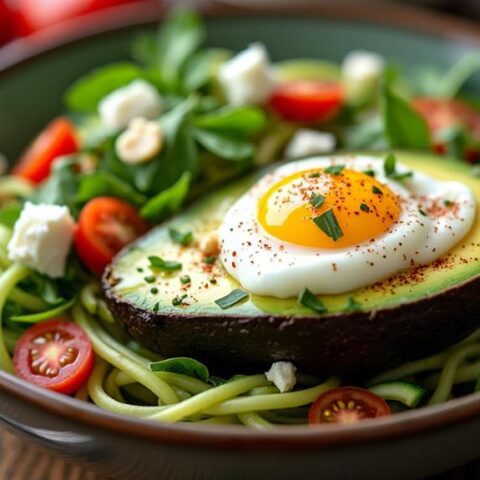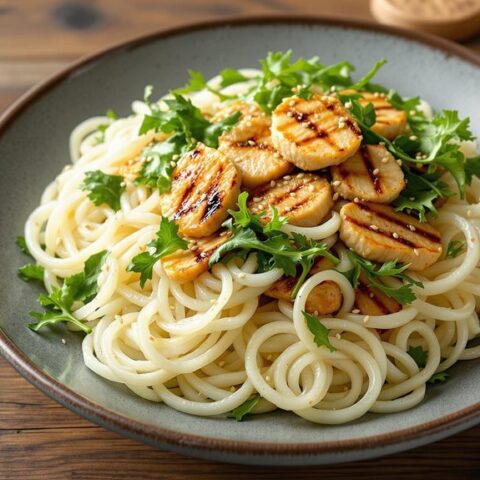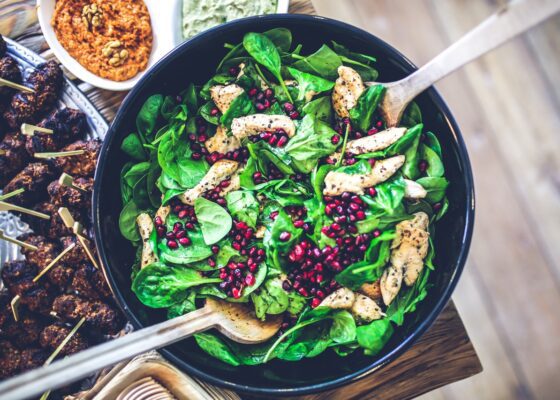
Traditional ramen noodles are not low-carb friendly, containing 40-80 grams of net carbs per serving, making them unsuitable for ketogenic or low-carb diets. These wheat-based noodles can spike blood sugar and disrupt metabolic health. However, several keto-friendly alternatives exist, including shirataki noodles (0-1g net carbs), kelp noodles (1g net carbs), and specialized products like Immi ramen (5-6g net carbs). Understanding the best low-carb substitutes can help maintain the comfort-food appeal while supporting dietary goals.
Key Takeaways
- Traditional ramen noodles contain 40-80 grams of net carbs per serving, making them incompatible with low-carb or keto diets.
- Zero-carb alternatives like shirataki noodles, kelp noodles, and palmini pasta provide keto-friendly options for ramen lovers.
- Regular ramen consumption can spike blood sugar levels and disrupt ketosis due to high wheat flour content.
- Keto-friendly ramen alternatives like Immi ramen contain only 5-6 grams of net carbs per serving.
- Low-carb ramen bowls can be created using veggie noodles, bone broth, and protein-rich toppings while maintaining authentic flavors.
Traditional Ramen's Carbohydrate Content
A closer examination of traditional ramen noodles reveals their substantial carbohydrate content, making them a challenging choice for those monitoring their carb intake.
Conventional ramen servings contain between 40-80 grams of net carbs, with chicken-flavored varieties averaging around 41 grams per cup, representing approximately 15% of daily carbohydrate recommendations.
The high carbohydrates in traditional ramen primarily come from wheat flour, which serves as the main ingredient in these popular noodles.
This significant carb content poses particular concerns for individuals following a low-carb diet, as it can quickly disrupt ketosis and potentially contribute to weight gain when consumed regularly.
For those seeking to maintain strict carbohydrate limits, traditional ramen's substantial carb content makes it an unsuitable option for regular meal planning.
The Science Behind Low-Carb Diets and Noodles
During ketosis, the body shifts from using carbohydrates as its primary fuel source to burning fat, which traditional ramen noodles can disrupt due to their high carbohydrate content. The digestion of regular wheat-based ramen noodles rapidly converts these carbohydrates into glucose, causing significant blood sugar fluctuations that can knock someone out of ketosis. Understanding this metabolic process explains why low-carb noodle alternatives have become essential for individuals following ketogenic diets, as these substitutes allow for the enjoyment of noodle dishes without compromising their metabolic state. The Keto diet's strict macronutrient composition ensures that the body remains in ketosis by limiting carbohydrate intake to 5-10%, making low-carb alternatives a critical part of maintaining this metabolic state.
Ketosis and Noodle Digestion
Understanding how traditional ramen noodles affect ketosis reveals why they pose a significant challenge for low-carb dieters. The noodle digestion process of traditional ramen, containing 40-80 grams of net carbs per serving, can quickly disrupt the metabolic state of ketosis, where the body primarily uses fat for fuel instead of carbohydrates.
For those committed to maintaining ketosis, the carbohydrate content of regular ramen noodles makes them incompatible with a low-carb lifestyle.
However, alternative low-carb noodles, such as shirataki or kelp varieties, offer a solution by providing similar texture with minimal impact on blood sugar levels. These alternatives, containing only 0-1 gram of net carbs per serving, allow individuals to enjoy noodle dishes while preserving their body's fat-burning state.
Carbs Impact Blood Sugar
The complex relationship between carbohydrates and blood sugar levels plays a crucial role in understanding why traditional ramen noodles present challenges for those following low-carb diets. With conventional ramen containing high carbohydrates, consumption leads to significant blood sugar spikes and increased insulin response, potentially disrupting metabolic health over time.
| Noodle Type | Net Carbs (g) | Blood Sugar Impact |
|---|---|---|
| Traditional Ramen | 40-80 | High |
| Shirataki Noodles | 0-1 | Minimal |
| Egg Noodles | 15-20 | Moderate |
For those monitoring their carbohydrate intake, low-carb alternatives like shirataki noodles offer a viable solution. These alternatives help maintain stable blood sugar levels while satisfying noodle cravings, making them particularly beneficial for individuals with diabetes or those following ketogenic diets.
Popular Keto-Friendly Ramen Alternatives
For those following a keto lifestyle, several zero-carb noodle alternatives offer excellent substitutes for traditional ramen noodles, with shirataki and kelp noodles leading the way in popularity. These alternatives can be easily transformed into satisfying keto ramen bowls by combining them with rich bone broth, protein sources like chicken or pork, and low-carb vegetables such as bok choy and mushrooms. The preparation process remains similar to traditional ramen, making the shift to these healthier options seamless while maintaining the comforting appeal of a classic ramen bowl. Additionally, Palmini Pasta, made from hearts of palm, is another popular low-carb choice that can be incorporated into keto ramen recipes for those looking to diversify their noodle options.
Best Zero-Carb Noodle Options
When following a low-carb or ketogenic diet, finding suitable alternatives to traditional ramen noodles becomes essential for maintaining dietary goals while enjoying favorite dishes. Several zero and low-carb options stand out for their versatility and nutritional profiles.
| Noodle Type | Net Carbs | Texture Profile |
|---|---|---|
| Shirataki | 0g | Firm, chewy |
| Kelp | 1g | Crunchy, tender |
| Heart of Palm | 1.6g | Al dente |
Shirataki noodles lead the pack as a true zero-carb option, while low-carb egg noodles provide a more traditional texture. Heart of palm noodles offer excellent firmness for ramen dishes, and zoodles add a fresh vegetable element with slightly higher but still manageable carb content. These alternatives allow ramen enthusiasts to maintain ketosis while enjoying their favorite Asian-inspired dishes.
Preparing Keto Ramen Bowls
Creating delicious keto ramen bowls begins with selecting appropriate low-carb noodle alternatives and complementary ingredients that maintain authentic flavors while adhering to ketogenic dietary guidelines.
When preparing keto-friendly ramen recipes, focus on incorporating nutrient-rich components while keeping carbohydrates minimal.
- Select low-carb noodles such as shirataki or kelp noodles, which provide the satisfying texture of traditional ramen without compromising the keto diet.
- Prepare a flavorful broth using low-sodium options or homemade varieties, enhancing taste while maintaining health benefits.
- Add protein-rich toppings like pork belly, soft-boiled eggs, or tofu, along with low-carb vegetables such as bok choy and bean sprouts.
For convenience, specially formulated options like Immi ramen offer ready-made solutions with only 5-6 grams of net carbs per serving, making keto ramen easily accessible.
Breaking Down Net Carbs in Different Ramen Types
Understanding the net carb content of different ramen types can help individuals make informed choices while maintaining their dietary goals.
Traditional instant ramen noodles contain between 40 to 80 grams of net carbs per serving, making them unsuitable for low-carb diets.
Traditional ramen's high net carb content makes it challenging for low-carb dieters to include this popular comfort food in their meals.
However, several alternatives are low in net carbs and offer better nutritional profiles.
Immi ramen provides a healthier option with only 5-6 grams of net carbs per serving, while Shirataki noodles contain zero net carbs, making them an excellent choice for strict low-carb dieters.
Kelp noodles present another viable alternative with just 1 gram of net carbs per serving.
These variations in carbohydrate content demonstrate that enjoying ramen while following a low-carb lifestyle is possible with the right noodle selection.
Additionally, insulin sensitivity can be improved by adhering to a low-carb diet like keto, which may further aid in managing blood sugar levels for those concerned with diabetes.
Health Impact of Regular vs. Low-Carb Ramen
Traditional instant ramen noodles contain significant hidden carbohydrates, ranging from 40 to 80 grams per serving, which can contribute to weight gain and increased health risks when consumed regularly. Health-conscious consumers now have access to innovative low-carb alternatives, including immi ramen and shirataki noodles, which provide similar satisfaction with only 5-6 grams of net carbs per serving. These alternative options, especially when combined with nutrient-rich toppings like vegetables and lean proteins, offer a more balanced approach to enjoying ramen while maintaining dietary goals and supporting better health outcomes. It is important to note that the keto diet can improve insulin sensitivity and reduce HbA1c levels, offering potential benefits for those managing Type 2 diabetes.
Traditional Ramen's Hidden Carbs
The hidden carbohydrate content in regular ramen noodles presents significant challenges for health-conscious consumers and those following specialized diets. Traditional ramen typically contains substantial amounts of carbohydrates, ranging from 40-80 grams per serving, which can contribute to weight gain and various health concerns.
When examining traditional ramen's nutritional profile, several concerning factors emerge:
- A single cup of instant ramen contains approximately 290 calories and 41 grams of carbs.
- Regular consumption can lead to significant nutritional deficits and increased health risks.
- The high carbohydrate load can disrupt metabolic processes, particularly for those following low-carb diets.
Understanding these hidden carbs is essential for making informed dietary choices, especially since regular ramen consumption has been linked to obesity, heart disease, and diabetes risk factors.
Low-Carb Alternatives Worth Trying
While traditional ramen poses challenges for health-conscious individuals, numerous low-carb alternatives have emerged to address these concerns, offering substantial nutritional benefits without sacrificing the beloved comfort-food experience.
Several innovative low-carb noodles present healthier options for ramen enthusiasts. Shirataki noodles contain zero net carbs, while kelp noodles offer just one gram, making them excellent substitutes for traditional wheat-based varieties.
Immi ramen has revolutionized the market with only 5-6 grams of net carbs per serving, providing a more authentic ramen experience while maintaining health benefits.
These low-carb alternatives not only help prevent issues associated with high-carb consumption but also support weight management and cardiovascular health. By choosing these alternatives, consumers can enjoy their favorite comfort food without compromising their dietary goals or overall wellness.
Creative Ways to Reduce Carbs in Ramen Dishes
Reducing carbs in ramen dishes requires creative alternatives and mindful ingredient substitutions, enabling enthusiasts to enjoy this beloved comfort food while maintaining a low-carb lifestyle.
By incorporating low-carb noodles like shirataki or kelp noodles, along with protein-rich ingredients and homemade low-sodium broth, individuals can create satisfying meals without compromising their dietary goals.
To maximize nutritional value while minimizing carbohydrates, consider these strategic approaches:
- Replace traditional wheat noodles with vegetable-based alternatives such as courgetti or shirataki.
- Build flavor with natural spices and herbs instead of pre-packaged seasoning.
- Load dishes with low-carb vegetables like bok choy, mushrooms, and spinach.
Including non-starchy vegetables such as spinach and cauliflower can enhance the nutritional profile of your ramen while supporting a low-carb diet.
These modifications allow for a hearty, flavorful bowl of ramen that aligns with low-carb dietary requirements while maintaining the essence of this classic dish.
Best Low-Carb Noodle Substitutes for Ramen
Finding suitable low-carb alternatives to traditional ramen noodles opens up a world of possibilities for health-conscious food enthusiasts. Several excellent options exist, each offering unique nutritional benefits and textures.
Shirataki noodles, containing zero net carbs, provide a satisfying jelly-like consistency, while low-carb egg noodles deliver rich flavor with only one gram of net carbs. Heart of palm noodles effectively mimic traditional pasta texture while maintaining a modest 1.6 grams of net carbs. For those seeking additional nutrients, zoodles offer a fresh alternative with six grams of net carbs.
Explore the versatility of shirataki and egg noodles, offering authentic ramen experiences while keeping carbs remarkably low.
Kelp noodles present another viable option, containing just one gram of net carbs while providing essential minerals like calcium and iodine, making them a nutritious choice for low-carb ramen dishes. Additionally, incorporating leafy greens, broccoli, cauliflower into your ramen can boost the nutritional value while keeping carb content low.
Making Your Own Keto-Compatible Ramen at Home
Creating a delicious keto-compatible ramen at home requires thoughtful ingredient selection and careful preparation techniques. Home cooks can start with low-carb noodle alternatives like shirataki noodles, combined with a high-quality broth that serves as the foundation for a satisfying meal.
For best results when preparing keto-friendly ramen, consider these essential elements:
- Select appropriate keto-friendly noodles, such as shirataki or egg-based alternatives.
- Incorporate protein sources like soft-boiled eggs, grilled chicken, or tofu.
- Add nutrient-rich vegetables including bok choy, bean sprouts, and mushrooms.
Almond Flour is a great option to use as a thickening agent in the broth, offering both a nutty flavor and a low-carb benefit. The key to success lies in balancing flavors through careful seasoning and spice selection, while maintaining minimal carbohydrate content. This approach allows individuals following a ketogenic diet to enjoy the comfort of ramen without compromising their dietary goals.
Essential Ingredients for Low-Carb Ramen Bowls
To build a satisfying low-carb ramen bowl, several essential ingredients work together to create a flavorful and nutritionally balanced meal. The foundation starts with low-carb noodle alternatives, such as shirataki or kelp noodles, which provide the classic ramen texture while maintaining minimal carbohydrate content.
| Component | Options | Benefits |
|---|---|---|
| Noodles | Shirataki, Kelp, Heart of Palm | 0-2g net carbs per serving |
| Proteins | Eggs, Tofu, Chicken | Adds satiety and nutrition |
| Add-ins | Bok Choy, Mushrooms, Seaweed | Increases vitamin content |
A homemade broth serves as the vital flavor base, offering better nutritional value than pre-packaged alternatives while keeping sodium levels in check. Incorporating varied vegetables and protein sources not only enhances the bowl's nutritional profile but also creates a more authentic ramen experience. Avocado oil is an excellent choice for sautéing vegetables due to its high smoke point and heart-healthy monounsaturated fats, ensuring your ramen remains both delicious and keto-friendly.
Expert Tips for Transitioning to Low-Carb Ramen
Successfully shifting from traditional ramen to low-carb alternatives requires strategic planning and an understanding of ingredient substitutions.
Experts recommend focusing on improving the nutritional profile while maintaining familiar flavors and textures through careful meal planning and mindful sodium intake management.
For ideal results when altering to low-carb noodles, consider these essential steps:
- Begin by substituting conventional noodles with shirataki or kelp alternatives in familiar recipes.
- Gradually incorporate more vegetables and protein sources to enhance satiety and nutrition.
- Replace high-sodium flavor packets with natural spices and homemade broths to control sodium levels.
Additionally, embracing healthy fats like avocados and olive oil can further enhance the nutritional value of your low-carb ramen, ensuring it aligns with your dietary goals. This methodical approach helps individuals maintain their enjoyment of ramen while adapting to healthier, low-carb options that support their dietary goals.
Common Mistakes When Choosing Low-Carb Ramen
Many health-conscious consumers make critical mistakes when selecting low-carb ramen alternatives, potentially undermining their dietary goals without realizing it. A common error is failing to thoroughly read the nutritional label, particularly for products marketed as "low-carb" that may still contain significant amounts of wheat flour or hidden carbohydrates. It is also important to avoid ramen products that incorporate starchy vegetables like potatoes or corn, as they contribute to higher carbohydrate content that is unsuitable for a keto diet.
| Mistake | Impact | Solution |
|---|---|---|
| Ignoring ingredient list | Hidden carbs from wheat flour | Check full ingredients list |
| Trusting marketing claims | Misrepresented carb content | Verify nutritional facts |
| Using flavor packets | Extra sodium, artificial additives | Create own seasoning blend |
To guarantee genuine low-carb noodles, consumers should specifically seek out options made from shirataki or kelp, which contain minimal net carbs and better align with ketogenic or low-carb dietary requirements.
Taste Test: Traditional vs. Low-Carb Ramen Options
Understanding the taste differences between traditional and low-carb ramen options can help consumers make informed choices about their noodle selections.
Recent taste tests comparing various alternatives have revealed notable distinctions in texture and flavor profiles. While traditional ramen noodles offer familiar comfort with their 40-80 grams of net carbs, low-carb alternatives provide satisfying options for health-conscious consumers.
Key findings from comparative taste tests include:
- Immi ramen maintains an authentic bite while containing only 5-6 grams of net carbs.
- Shirataki noodles offer zero net carbs but present a unique, jelly-like texture.
- Low-carb egg noodles strike a balance between traditional texture and carb reduction at 1 gram of net carbs.
These alternatives demonstrate that consumers can enjoy ramen while adhering to their dietary preferences, though texture and mouthfeel may vary between options.
Frequently Asked Questions
Can I Eat Ramen on a Low-Carb Diet?
Traditional ramen noodles aren't suitable for low-carb diets, but low-carb alternatives exist. Modified ramen noodle recipes with healthy toppings and portion control can accommodate carb-conscious eating while maintaining flavor satisfaction.
Are Ramen Noodles High in Carbs?
Ramen nutrition facts confirm high carb content, typically containing 40-80 grams per serving. Traditional instant ramen offers minimal health benefits. Low-carb alternatives like shirataki noodles provide better carb content comparison for health-conscious consumers.
What Type of Noodle Is Lowest in Carbs?
Shirataki noodles, made from konjac yams, contain zero net carbs, making them the lowest-carb option among zoodle alternatives. These translucent noodles offer versatility similar to cauliflower rice for carb-conscious consumers.
Should I Slurp My Ramen?
Noodle slurping is widely accepted ramen etiquette in Japanese culture, enhancing the dining experience through better flavor appreciation and temperature control. The cultural significance makes it an encouraged practice when enjoying authentic ramen.
Conclusion
Traditional ramen noodles remain a high-carb food choice, making them unsuitable for low-carb or ketogenic diets. However, alternatives like shirataki, zucchini noodles, and other vegetable-based options provide satisfying solutions for those monitoring their carbohydrate intake. By choosing these substitutes and focusing on rich broths and protein-packed toppings, individuals can enjoy the comfort of ramen while maintaining their dietary goals. The key lies in mindful ingredient selection and proper portion control.










No Comments